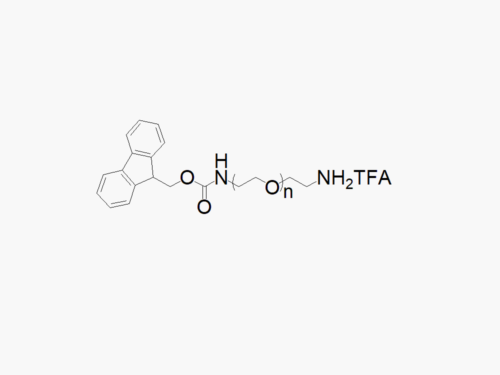PEG products with additional MW may be made to order, please contact us for details
Thiol PEG Acetic Acid
$300.00 – $1,400.00
Description
High quality Thiol PEG Acetic Acid with standard quality specification of ≥95% Substitution.
Heterobifunctional Thiol PEG Acetic Acid (HS-PEG-CM, or SH-PEG-COOH) products from JenKem Technology are generally employed as crosslinking agents or as spacers between two different chemical entities, such as a gold nanoparticle and an antibody. The PEG moiety in the heterofunctional PEG derivatives provides water solubility, biocompatibility, and flexibility.
Heterobifunctional PEGylation reagents with molecular weights, branching, and functional groups not listed in our online catalog may be available by custom synthesis. Please inquire at tech@jenkemusa.com about pricing and availability of custom PEGs.
Bulk PEGs and GMP grade PEGs are made-to-order. Please contact us for bulk pricing.
Click here to download the MSDS
References:
- Bolanos, K, et al., NIR and glutathione trigger the surface release of methotrexate linked by Diels-Alder adducts to anisotropic gold nanoparticles. Materials Science and Engineering: C. 2021, 112512.
- Tapia-Arellano, A., et al., Functionalization with PEG/Angiopep-2 peptide to improve the delivery of gold nanoprisms to central nervous system: in vitro and in vivo studies, Materials Science and Engineering: C, 2021, 121, 111785.
- Zhao, B., et al., Single-step, wash-free digital immunoassay for rapid quantitative analysis of serological antibody against SARS-CoV-2 by photonic resonator absorption microscopy, Talanta, 2021, 225, 122004
- Cheng, X., et al., Furin Enzyme and pH Synergistically Triggered Aggregation of Gold Nanoparticles for Activated Photoacoustic Imaging and Photothermal Therapy of Tumors. Analytical Chemistry. 2021.
- Hue, DT, et al., The dependence of medium refractive index on optical properties of gold nanorods and their SERS application. AIP Advances. 2021, 11(5):055319.
- Shi, H., et al., Tumor-targeting CuS nanoparticles for multimodal imaging and guided photothermal therapy of lymph node metastasis, Acta biomaterialia, 2018, 72, pp.256-265.
- Luan, J., et al., Environmental Stability of Plasmonic Biosensors based on Natural vs. Artificial Antibody, Analytical chemistry, 2018.
- Mao, W., et al., Doxorubicin encapsulated clicked gold nanoparticle clusters exhibiting tumor-specific disassembly for enhanced tumor localization and computerized tomographic imaging, Journal of Controlled Release, 2018, 269: 52-62.
- Koshkina, O., et al., Tuning the Surface of Nanoparticles: Impact of Poly (2‐ethyl‐2‐oxazoline) on Protein Adsorption in Serum and Cellular Uptake. Macromolecular Bioscience, 2016.
- Liu, J., et al., A label-free impedimetric cytosensor based on galactosylated gold-nanoisland biointerfaces for the detection of liver cancer cells in whole blood, Journal of Electroanalytical Chemistry, 2016.
- Garcia, J., New strategies based on nanosystems to facilitate the crossing through biological barriers, Universitat de Barcelona, 2016.
- Tadepalli, S., et al., Peptide Functionalized Gold Nanorods for the Sensitive Detection of a Cardiac Biomarker Using Plasmonic Paper Devices, Scientific Reports, 2015, 5, 16206.
- Gao, Y., et al., Multifunctional gold nanostar-based nanocomposite: Synthesis and application for noninvasive MR-SERS imaging-guided photothermal ablation, Biomaterials, 2015, 60: 31-41.
- Li, B., et al., Sample-free quantification of blood biomarkers via laser-treated skin, Biomaterials, 2015, 59, P. 30-38.
- Wang, L., et al., Sea-Urchin-Like Au Nanocluster with Surface-Enhanced Raman Scattering in Detecting Epidermal Growth Factor Receptor (EGFR) Mutation Status of Malignant Pleural Effusion, ACS Applied Materials & Interfaces, 2015, 7 (1), 359-369.
- Walker, J. M., et al, Non-Enzymatic Remodeling of Fibrin Biopolymers via Photothermally Triggered Radical-Generating Nanoparticles, Chem Mater, 2014, 26(17) p: 5120–5130.
- Tian, L., et al., Bioplasmonic calligraphy for multiplexed label-free biodetection. Biosensors and Bioelectronics, 2014, 59(0): p. 208-215.
- Zhuo, Y., et al., Protein-protein binding detection with nanoparticle photonic crystal enhanced microscopy (NP-PCEM), Engineering in Medicine and Biology Society, 2014, 3, P: 2069 – 2072.
- Zhuo, Y., et al., Single nanoparticle detection using photonic crystal enhanced microscopy, Analyst, 2014, 139, 1007-1015.
- Shaw, C.P., et al., Statistical Correlation Between SERS Intensity and Nanoparticle Cluster Size, J. Phys. Chem. C 2013, 117, 16596−16605.
- Dai, M.Q., et al., Ethylenediamine-Assisted Ligand Exchange and Phase Transfer of Oleophilic Quantum Dots: Stripping of Original Ligands and Preservation of Photoluminescence, Chem. Mater., 2013, 25(11), p: 2193–2201.
- Nam, K., et al., Paclitaxel-conjugated PEG and arginine-grafted bioreducible poly (disulfide amine) micelles for co-delivery of drug and gene. Biomaterials, 2012, 33(32), p. 8122-8130.
- Wang, H., et al., Preparation and characterization of pore-suspending biomimetic membranes embedded with Aquaporin Z on carboxylated polyethylene glycol polymer cushion, Soft Matter, 2011, 7, 7274-7280.
Note: Starting July 2016, Thiol PEG Acetic Acid is the new name of the product Thiol PEG Carboxyl (MW 2000 (HS-PEG2000-CM), MW 3500 (HS-PEG3500-CM), MW 5000 (HS-PEG5000-CM) and MW 7500 (HS-PEG7500-CM)). JenKem Technology has revised the name of the product to better reflect the chemical structure, as many other PEG derivatives with a COOH group are offered in the 2016 JenKem USA catalog.
Founded in 2001 by experts in PEG synthesis and PEGylation, JenKem Technology specializes exclusively in the development and manufacturing of high quality polyethylene glycol (PEG) products and derivatives, and related custom synthesis and PEGylation services. JenKem Technology is ISO 9001 and ISO 13485 certified, and adheres to ICH Q7A guidelines for GMP manufacture. The production of JenKem® PEGs is back-integrated to in-house polymerization from ethylene oxide, enabling facile traceability for regulated customers. JenKem Technology caters to the PEGylation needs of the pharmaceutical, biotechnology, medical device and diagnostics, and emerging chemical specialty markets, from laboratory scale through large commercial scale.






